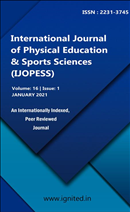Estimation of time duration on the Basis of Decrease in Elbow Joint Angle for Successful Application of Choke in Judo
Main Article Content
Authors
Abstract
The purpose of this study was the estimation of time duration for successful application ofchoke in judo on the basis of decreasing the elbow joint angle. The kinetic variable time was chosen asthe independent variable and the angle between elbow joint , biceps pumped, and forearm, as thedependent variable. Total six boys students of B.P.Ed, studying in LNIPE were chosen as the subject.Their age ranged between 18 to 21years. They were briefed about the objectives of the study after gettingthe consent form signed by their parents. The All India national level participation in JUDO was thedeciding criteria for the identification of sports group. To find out the angle and time, the movement werecaptured by the videography and kinovea 2D software was used. The regression analysis was used as astatistical technique and the data was analyzed by using SPSS. The level of significance was set at 0.05.The result of study shows that biceps pumped and forearm has a direct relation to the angle of the elbowjoint which is responsible for decreasing the time of unconscious.
Downloads
Download data is not yet available.
Article Details
Section
Articles
References
- Takashiko Ishikawa And Donnf.Draeger, Dreager“,Judo Training Methods” (Tokyo:Charles E, Tuttle Company, 1964),Pp.78-79
- MukeshKumar,”Action Judo” (Delhi:Sports Publication,1994),Pp.23
- Barraw,Hararold M. “Man And Movement: Principle Of Physical Education” 3rd Ed. Philadelphia: Lea And Fibiger, 1983.
- Thekodakon, Judo Japan; NunoishopoCo.Ltd.,(1961),Pp.148.
- Butcher, Alex.Judo London : New Holland Publication Ltd. 2001
- Dull. Charles E. “Modern Physics” New York: Holl Rinehart And Winston Inc.,1960.
- Glass, Geoger,” Know The Game Judo” 2nd Ed. Englan: E.P Publishing Ltd.1988.
- Griffiths,Cerri. “Understanding How Judo Technique Work: A Biomechanical Explanation”, 1999.
- Ishikaqwa, Takashiko and Draegerdon F. “Judo Training Methods” Tokyo, Charles E.Tuttle Company,1964.
- KreighbaumRllen and Barthels K.M” Biomechanics” 1994.
- Reay Tony Hobbs Geffrey.”Judo Manual” London: Barrie And Jankinscompany,1992.
- Smith, Robert W. A Complete Guide To Judo Japan: Cgarles E Tuttle Co., 1958.
- Zumikoi, G. My Study Of Judo London :W.Foulshran and Co.,1960.
- Pucsoc J.M, Nelson K. and ED Ng. (2001) “A kinetic and kinematic analysis of the Harai-goshijudotechnique”.Actaphysiologicalhungaricahttps://doi.org/10.1556/A physiol.88.2001.3-4.9
- M.Ikai,T.Ishiko,G.Ueda.(1958) “Physiological Studies On "choking" in judo”. chokinghttps://www.researchgate.net/publication/313119075_Physiological_Studies_On_choking_in_judo/citations
- RodeneyT.Imamura, Alan Hreljac,Rafel F. Ecamilla, and w. brent Edwards.(2006).”A Three-Dimensional Analysis of the Centre Of Mass For three different judo throwing techniques” journal of sports science and medicine.(CSSI):122-131..
- Takanoriishii, michiyashi A (2014) biomechanics factors of effective seoi-nage, 32nd international conference of biomechanics in sports issn 1999-4168.

